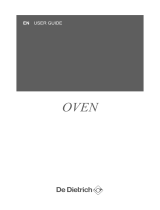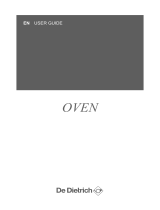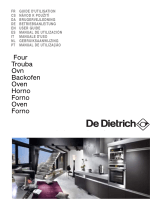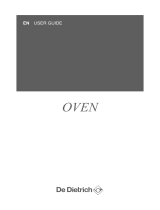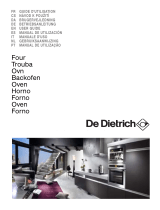Page is loading ...

DEAR
CUSTOMER,
EN
Discovering a De Dietrich product means experiencing
the range of unique emotions.
The attraction is immediate, from the moment you set eyes on the product.
The sheer quality of the design shines through, thanks to the timeless style
and outstanding finishes which make each component an elegant and
refined masterpiece in its own right, each one in perfect harmony with the
others. Next, comes the irresistible urge to touch it.
De Dietrich design makes extensive use of robust and prestigious
materials, where the accent is place firmly upon authenticity. By combining
state-of-the-art technology with top quality materials, De Dietrich produces
beautifully crafted products to help you get the most from the culinary arts,
a passion shared by all lovers of cooking and fine food. We hope that you
enjoy using this new appliance.
Thank you for choosing a De Dietrich product.

2
CONTENTS
EN
Description of the oven......................................................................3
The control panel..................................................................................3
Light - Shelf runners - Accessories ......................................................4
Settings................................................................................................5
Setting the clock ..................................................................................5
Changing the clock ..............................................................................5
Minute Minder ......................................................................................5
Locking the controls..............................................................................5
Settings menu ......................................................................................5
Cooking ..............................................................................................6
«EXPERT» mode ................................................................................6
- Immediate cooking ..........................................................................6
- Programme the temperature, the time ............................................6
- Delayed start time ..........................................................................7
- Memorise a cooking mode ..............................................................7
- Cooking functions in «Expert» mode ..............................................8
- «LOW TEMPERATURE» mode........................................................11
- «RECIPES» mode............................................................................12
- Hints and Tips................................................................................13
Care....................................................................................................14
External surface..................................................................................14
Removing the shelf runners................................................................14
Installing and removing the sliding rails..............................................14
Cleaning the inner glass ....................................................................14
Removing and putting back the door..................................................14
Pyrolytic self-cleaning ........................................................................15
Replacing the light bulb ......................................................................16
Anomalies and solutions ................................................................16

3
•
1DESCRIPTION OF THE OVEN
Cooking modes display
Shelf runner indicator
Temperature rise indicator
Cooking time display
Oven temperature and clock display
Weight display
Minute minder and cooking end time
display
CONTROL PANEL
THE DISPLAY
•
On/Off
Adjusting the temperature
Adjusting the clock, the time and the
end of cooking, the minute minder
Access the settings MENU
This is a rotating knob with central button to choose programmes, increase or
reduce values and confirm.
The drawings on the control knob are symbolised as follows:
BUTTONS
1
2
3
4
5
6
7
1
2
3
4
5
6
7
1
2
3
4
•
CONTROL KNOB
•
1
2
3
4
Control locking indicator
“Low temperature” function indicator
“Recipes” function indicator
Cleaning indicator
Cooking time indicator
Minute minder indicator
Cooking end time indicator
PRESS the centre of the
knob to confirm.
TURN the knob.
1

4
•
1DESCRIPTION OF THE OVEN
THE LIGHT
2
For characteristics and to find out how to
remove the light bulb, refer to the «Care»
chapter.
4
ACCESSORIES
(depending on model)
Anti-tip safety rack
(fig. A).
The rack can be used to support all dishes
and moulds containing food for cooking or
browning. It can be used for grilling (placed
directly on top).
Insert the anti-tip handle towards the back
of the oven.
Multi-purpose tray, drip tray, 45 mm
(fig. B).
When inserted in the shelf runners under
the grill with the handle towards the oven
door, it collects juice and fat from grilling,
and can be used half-filled with water as a
double-boiler.
Pastry dish, 20 mm (fig. C).
Insert in the shelf runners with the handle
towards the oven door. Ideal for baking
cookies, shortbread and cupcakes. The
tilted surface makes it easier for you to put
your preparations in a dish. Can also be
inserted into the shelf runners under the grill
to collect juice and fat from grilling.
«Flavour» grills (fig. D)
These half «flavour» grills are used
separately, but only when placed in one of
the dishes or drip tray with the anti-tip
handle towards the back of the oven.
By using just one grill, it is easy to moisten
your food with the cooking juices collected
in the dish.
Sliding rail system (fig. E)
The new sliding rail system makes food
more practical and easier to handle as the
trays can be effortlessly pulled for simpler
handling. The trays can be completely
removed, providing full access. Their
stability ensures that food can be handled
safely, reducing the risk of burns. This
means that you can take food out of the
oven far more easily.
Remove the accessories and
supports from the oven before
beginning pyrolysis cleaning.
Advice
To avoid fumes when cooking fatty
meats, we recommend you add a small
amount of water or oil to the bottom of
the drip pan.
The accessories may warp with the
effect of heat, but this will not alter
their function. They will return to their
original shape once cooled.
SHELF RUNNERS AND LINERS
This oven has 6 shelf runners to position
accessories (grill, dish, etc.) at different
heights depending on the cooking mode
chosen.
Behind these shelf runners there are ca-
talytic liners (depending on model) on
each side which recover some of the
grease from the cooked food. Refer to the
«Care» chapter on how to replace them.
3

5
•
2SETTINGS
SETTING THE CLOCK (fig. A)
When switching on, the display flashes at
12:00.
Adjust the hours by turning the knob,
then press to confirm. Do the same for
the minutes.
If there is a power cut, the clock flashes.
CHANGING THE CLOCK (fig. B)
Press the button for a few seconds
until the clock flashes. Adjust the clock by
turning the knob and then press to
confirm.
MINUTE MINDER (fig. C)
This function can only be used when the
oven is off.
Press .
00:00 flashes. Set the minute minder by
turning the knob and then press to
confirm. The timer starts.
Once the time has lapsed, there is a
sound signal. To stop it, press any key.
NB: You can modify or cancel the minute
minder at any time.
To cancel, return to the timer’s menu and
set to 00:00.
If you do not confirm, it will be saved
automatically after a few seconds.
CONTROL LOCKING Child safety
(fig. D)
Press and at the same time until
the symbol appears on the screen.
Control locking is accessible during
cooking or when the oven has stopped.
N.B.:only the button remains active.
To unlock the keypad, press and
together until the symbol disappears
off the screen.
SETTINGS MENU (fig. E)
You can adjust different settings on your
oven:
light, contrast, sounds and demo mode.
To do this, press for a few seconds to
access the settings menu.
See the table below:
To modify the different settings if
necessary, turn the control knob and then
press to confirm.
To come out of the settings menu at any
time, press .
Light:
Position ON, the light stays
on throughout cooking
(except in ECO mode).
Position AUTO, the oven
light turns off after 90
seconds when cooking.
Sounds - beeps:
Position ON, sounds active.
Position OFF, no sounds.
Contrast:
The brightness of the
display is adjustable from
10 to 100%.
DEMO mode:
Position ON, mode active.
Position OFF, normal
mode.
Default
settings

6
•
3COOKING
- Then select the type of cooking from the
following list by turning the control knob
and then press to confirm.
FAN OVEN VARIABLE GRILL
COMBINED OVEN KEEP WARM
CONVENTIONAL OVEN DEFROSTING
ECO BREAD
PULSED MEDIUM GRILL DRYING
PULSED BOTTOM
IMMEDIATE COOKING (fig. A)
The programmer must only display the
time. It should not be flashing.
Turn the control knob until you get to the
cooking function of your choose, then
confirm.
The temperature starts to increase at
once. Your oven recommends one (or
two) shelf height(s) and a modifiable
temperature.
The oven heats up and the temperature
indicator flashes. A series of beeps
sounds when the oven has reached the
programmed temperature.
CHANGING THE TEMPERATURE(fig.
B)
When you are in the cooking mode of
your choice, press .
Adjust the temperature by turning the
knob and then press to confirm.
Before using your oven for the
first time, heat it at maximum
temperature while empty for
approximately 30 minutes. Make sure
that the room is sufficiently ventilated.
«EXPERT» MODE
The Expert function lets you set the
cooking parameters yourself:
temperature, cooking type, cooking time.
- Access the “Expert” screen by pressing
or turning the knob or by pressing or
.
COOKING
This oven gives you access to three
different types of programming
depending on the degree of knowledge
you have about the recipe in question:
- For a recipe where you know all the
settings (you choose the type of cooking,
temperature and cooking time yourself),
select «EXPERT» mode.
- For a recipe where you need
assistance from the oven (simply choose
the type of food from a list and the
weight; the oven will select the most
suitable settings: temperature, cooking
time, type of cooking), select
«RECIPES» mode.
- For a recipe managed entirely by the
oven thanks to a specific electronic
programme in order to obtain unrivalled
tenderness of meat and exceptional
flavours, select “LOW TEMPERATURE”
mode.

7
•
3COOKING
COOKING MODE
RECOMMENDATION
OF COOKING TIME
FAN OVEN
30 min
COMBINED OVEN
30 min
CONVENTIONAL OVEN
30 min
ECO
30 min
PULSED GRILL
15 min
PULSED BOTTOM
30 min
VARIABLE GRILL
7 min
KEEP WARM
60 min
DEFROSTING
60 min
BREAD
40 min
DRYING
5 hours
DELAYED START (fig. D)
Proceed as for programmed cooking.
After setting the cooking time, press .
The display flashes. Set the cooking end
time by turning the knob.
The cooking end time is automatically
saved after a few seconds. The cooking
end time display stops flashing.
MEMORISE A COOKING MODE
You can memorise 3 cooking
programmes of your choice.
- Programme a memory
(fig. E):
In Expert mode, select a cooking mode,
the temperature and time and then press
the knob until you get to «MEM 1».
Choose one of the 3 memories by turning
the control knob and confirm to
memorise it. Confirm again to start
cooking.
NB: If the 3 memories are saved, any new
memorisation will replace the previous
one.
A delayed start cannot be programmed
for memorisations.
- Select one of the 3 memories already
saved (fig. F):
Turn the knob and go to MEMO, then
confirm. Scroll through the memories
with the knob and confirm the one you
want. Cooking starts, you can now delay
your start time.
PROGRAMMING THE COOKING TIME
(fig. C)
Use the immediate cooking programme,
then press ; the cooking time flashes
and it is now possible to set it.
Turn the knob to adjust the cooking time.
Press to confirm.
Your oven has the “SMART ASSIST”
function which, when programming a
cooking time, will suggest a cooking time
which can be modified depending on the
selected cooking mode.
The time starts to count down as soon
as the cooking temperature is
reached.
The cooking time is saved automatically
after a few seconds.

8
Pulsed grill
Roasts and poultry are juicy and crisp all over.
Slide the drip tray on to the bottom shelf
support.
Recommended for all spit-roasted poultry or
meat, for sealing and thoroughly cooking a leg
or a rib of beef. To retain the moist texture of
fish steaks.
200°C
100°C - 250°C
ECO*
This setting saves energy while
maintaining the quality of the cooking. In
this setting, pre-heating is not required.
200°C
35°C - 275°C
Conventional
oven
Recommended for meat, fish,
vegetables, preferably in an earthenware
dish.
200°C
35°C - 275°C
*Cooking mode as per standard EN 60350-1: 2016 to demonstrate compliance with requirements of the
energy label of European regulation UE/65/2014.
Combined
oven*
Recommended for keeping white meat,
fish and vegetables moist. For cooking
multiple items on up to three levels.
Position
Use
180°C
35°C - 250°C
Combined
oven
Recommended for meat, fish,
vegetables, preferably in an earthenware
dish.
205°C
35°C - 230°C
T°C recommended
mini - maxi
Pre-heat your oven empty before cooking.
•
3COOKING
COOKING FUNCTIONS IN «EXPERT» MODE
(depending on model)
Pulsed bot-
tom
Recommended for meat, fish,
vegetables, preferably in an earthenware
dish.
180°C
75°C - 250°C

9
Variable grill
Recommended for grilling cutlets,
sausages, toasting bread and prawns
placed on the grill. Cooking is done by the
upper element. The grill covers the entire
shelf surface.
4
1 - 4
Keep
warm
Recommended for letting dough rise for
bread, brioche, kügelhopf.
Put the mould on the bottom, not
exceeding 40°C (plate-warming,
defrosting).
60°C
35°C - 100°C
Defrosting
Ideal for delicate dishes (fruit tarts,
custard pies, etc.). Meat, rolls, etc. are
defrosted at 50°C (meat should be placed
under the grill with a dish underneath to
catch the drips).
35°C
30°C - 50°C
Bread
Recommended cooking sequence for
bread making. Pre-heat, then place the
ball of dough on a baking sheet - 2nd
shelf. Do not forget to place a dish of
water in the bottom to obtain a crisp,
golden crust.
205°C
35°C - 220°C
Drying
Sequence to dehydrate certain food such
as fruits, vegetables, seeds, roots,
seasoning plants and herbs. Refer to the
specific drying table below.
80°C
35°C - 80°C
Position
Use
T°C recommended
mini - maxi
Advice on how to save energy
Avoid opening the door during cooking to avoid heat escaping from the
oven.
•
3COOKING
Never place tin foil directly in contact with the oven floor as the build
up of heat may damage the enamel.

10
Drying is one of the oldest methods of
preserving food. The aim is to remove all
or some of the water in the food to
preserve foodstuffs and prevent the
development of microbes. Drying
preserves the nutritional qualities of food
(minerals, proteins and other vitamins). It
allows food to be stored in optimal
conditions thanks to their reduced size
and makes food easy to use once re-
hydrated.
Only use fresh food.
Wash the food carefully, drain and wipe.
Cover the grill in parchment paper and
distribute the cut food evenly on top.
Use shelf level 1 (if you have several grill
pans, put them on levels 1 and 3).
Turn the food over several times during
drying. The values provided in the table
may vary depending on the type of food
to dehydrate, its maturity, its thickness
and its humidity rate.
•
3COOKING
DRYING FUNCTION
Guide table to dehydrate your food
Fruits with seeds (in 3 mm slices, 200
g per grill pan)
Fruits with stones (plums)
Sliced mushrooms
Tomato, mango, orange, banana
Edible roots (carrots, parsnips),
grated and blanched
80°C
80°C
80°C
60°C
60°C
5-9
8-10
5-8
8
8
Sliced red beetroot
60°C
6
1 or 2 grill pans
1 or 2 grill pans
1 or 2 grill pans
1 or 2 grill pans
1 or 2 grill pans
Herbs
60°C
6
1 or 2 grill pans
1 or 2 grill pans
Time in
hours
Accessories
Fruits, vegetables and herbs
Temperature

11
•
3COOKING
«LOW TEMPERATURE» MODE
(depending on model)
Cooking absolutely must begin in a “LOW
TEMPERATURE” oven.
This cooking mode makes meat fibres
tender thanks to slow cooking at low
temperature.
Cooking quality is optimal.
IMMEDIATE COOKING (fig. G)
Turn the control knob to the «low
temperature» cooking function.
The symbol and «Lt» are displayed on
the screen.
- Confirm the selection by pressing the
control knob.
«P01» flashes, you have to choose your
dish by turning the knob.
The oven offers a choice of 10 dishes:
P01 Roast veal (4 hours)
P02 Roast beef rare (3 hours)
P03 Roast beef well done (4 hours)
P04 Roast pork (5 hours)
P05 Rosé lamb (3 hours)
P06 Lamb well done (4 hours)
P07 Chicken (6 hours)
*P08 Small fish (1 hour 20)
*P09 Large fish (2 hours 10)
*P10 Yoghurt (3 hours)
- Select your dish.
- Once the dish has been selected, for
example: P01 (roast veal), put your meat
on the grill pan in the upper level (level 2)
and slide the drip pan below (level 1).
* N.B.: Do not use the grill pan for
programmes P08-P09-P10. Put them
directly on the drip tray on the shelf level
shown on the screen.
- Confirm the selection by pressing the
control knob. Cooking starts.
When cooking is complete, the oven
switches off automatically and rings for
10 minutes.
- Press a button to stop the beeping.
Cooking at low temperature
requires food to be extremely
fresh. For poultry, it is important to
rinse the outside and inside with
cold water and to dray with
absorbent paper before cooking.
DELAYED START (fig. H)
You can choose a delayed «low
temperature» start.
After selecting your programme, press
. The display flashes. Set the cooking end
time by turning the knob.
The cooking end time is automatically
saved after a few seconds. The cooking
end time display stops flashing.
If your oven is too hot to start low
temperature cooking, the word
«Hot» is displayed on the screen.
Leave the oven to cool.

12
•
3COOKING
«RECIPES» MODE
The “Recipes” function selects the
appropriate cooking parameters for you
based on the food being prepared and its
weight.
IMMEDIATE COOKING (fig. I)
Select «Guide» on the screen by turning
the knob and then confirm.
The symbol is displayed and
«Guide» shows on the screen.
There are 35 (or 15, depending on the
model of your oven) pre-programmed
recipes. See the 2 tables below.
Use the control knob to scroll through the
food choices and press to confirm.
A suggested weight flashes on the
screen. Enter the actual weight of your
food by turning the knob, then confirm.
The oven automatically calculates the
ideal cooking time and displays it.
Cooking starts immediately.
DELAYED START (fig. J)
If you wish, you can change the cooking
end time by pressing and displaying
the new cooking end time when the oven
has started.
Confirm by pressing the knob.
The oven stops and will start later so that
cooking ends at the desired time.
For sequences which require pre-
heating, it is not possible to use the
delayed start function.
Food
35
Recipes
Chicken
P01
Duck
P02
Duck breast
* P03
Turkey
P04
Rosé shoulder of lamb
P05
Rare beef
P06
Beef medium done
P07
Well-cooked beef
P08
Roast pork
P09
Roast veal
P10
Veal chops
* P11
Salmon
P12
Trout
P13
Fish terrine
P14
Lasagne
P15
Potato gratin
P16
Stuffed tomatoes
P17
Baked potatoes
P18
Puff pastry
P19
Pizza
P20
Quiche
P21
Shortcrust pastry
P22
Leavened dough
P23
Fruit tart
P24
Crumble
P25
Sponge cake
P26
Cupcakes
P27
Crème caramel
P28
Biscuits
* P29
Cake
P30
Yoghurt cake
P31
Meringues
P32
Brioche
P33
Bread
P34
Baguette
P35
*Pre-heat before placing the dish in
the oven.

13
•
3COOKING
*Pre-heat before placing the dish in
the oven.
HINTS AND TIPS
• Beef, pork, lamb
- Always remove meat from the
refrigerator well before cooking: cold-hot
temperature shocks toughen meat; this
way you will produce a roast beef that is
golden outside, red inside and warm in
the middle.
Do not salt before cooking: salt absorbs
the blood and dries out the meat. Turn
the meat over using spatulas; if you
pierce it, the blood will run out. Always
leave meat to rest for 5 to 10 minutes
after cooking. Wrap it in foil and put it at
the oven’s entrance; the blood attracted
outside during cooking will return inside
and moisten the meat.
- Use earthenware roasting dishes; glass
tends to get splattered in grease.
- Do not cook in the enamelled drip tray.
- Avoid sticking garlic cloves into a leg of
lamb, this will cause it to lose its blood;
rather slip the garlic between the meat
and the bone or cook unpeeled cloves
alongside the lamb and crush them when
cooking is complete to season the sauce;
strain it and serve it very hot in a gravy
boat.
• Fish
- When you buy it, it should smell
pleasant and not too “fishy”.
- The body should be firm and rigid and
the scales should be firmly attached to
the skin; the eyes should be bright and
rounded and gills will appear shiny and
moist.
• Tarts, quiches
- Avoid glass or porcelain dishes as they
are too thick and extend the cooking time
and the bottom of the crust is not crispy.
- With fruits, the bottom of the tart may
become soggy: just add a few spoonfuls
of fine semolina, crushed biscuit crumbs,
almond powder or tapioca, which will
absorb the juice during cooking.
- With high-water content or frozen
vegetables (leeks, spinach, broccoli or
tomatoes) you can sprinkle a tablespoon
of cornmeal.
• Pizza
- To prevent cheese or tomato sauce
from dripping in the oven, you can place
a piece of parchment paper between the
shelf and the pizza.
Food
15
Recipes
Chicken
P01
Duck breast
* P02
Rare beef
P03
Pizza
P04
Roast pork
P05
Potato gratin
P06
Rosé shoulder of lamb
P07
Roast veal
P08
Salmon
P09
Fish terrine
P10
Quiche
P11
Stuffed tomatoes
P12
Biscuits
* P13
Cake
P14
Brioche
P15

14
EXTERNAL SURFACE
Use a window washing product applied
to a soft cloth. Do not use abrasive
creams or scouring sponges.
REMOVING THE SHELF RUNNERS
(fig. A)
Lift the front part of the shelf runner
upwards. Press the entire shelf runner
and release the front hook from its
housing. Then, gently pull the whole of
the shelf runner towards you to release
the rear hooks from their housing. Pull
out the two shelf supports.
INSTALLING AND REMOVING THE
SLIDING RAILS (fig.B)
(depending on model)
After removing the 2 shelf runners,
choose the height (2 to 5) at which you
want to fit your rails. Snap the left rail
against the left shelf runner by applying
enough pressure to the front and back
of the rail so that the 2 tabs on the side
of the rail slot into the shelf runner. Do
the same for the right-hand rail.
NOTE: the telescopic sliding part of the
rail must unfold towards the front of the
oven, with the buffer opposite you.
Insert your 2 shelf runners and then put
your tray on the 2 rails. The system is
now ready to use.
To remove the rails, remove the shelf
runners again.
Slightly prise apart the bottom of the tabs
fixed on each rail to release the shelf
runner. Pull the rail towards you.
CLEANING THE INNER GLASS
To clean the inner glass, remove the
door. Before doing this, remove any
excess grease with a soft cloth and
washing up liquid.
Warning
Do not use scouring products,
abrasive sponges or metal scrapers to
clean the glass oven door as this
could scratch the surface and cause
the glass to shatter.
REMOVING AND PUTTING BACK THE
DOOR (fig. C)
Open the door fully and block it with one
of the plastic wedges provided in your
appliance’s plastic pouch.
Remove the first clipped glass panel:
Using the other wedge (or a screwdriver),
press the slots to unclip the glass.
Remove the glass panel.
The door consists of two additional glass
panels, with a black rubber spacer at
each corner. If necessary, remove them
to clean them.
Do not soak the glass panels in water.
Rinse with clean water and dry off with a
lint-free cloth.
After cleaning, reposition the four rubber
stops with the arrow upwards and
reposition all of the glass panels.
Insert the last glass panel into the metal
stops, then clip it in with the side with
«PYROLYTIC» facing you and legible.
Remove the plastic wedge.
Your appliance is now ready for use
again.
A
•
4CARE

15
•
4CARE
PYROLYTIC SELF-CLEANING
This oven is equipped with a pyrolytic
self-cleaning function:
Pyrolysis is a cycle during which the oven
cavity is heated to a very high
temperature in order to eliminate soiling
from splattering and spills.
Before starting pyrolysis cleaning,
remove any large overspills, if any.
Remove the excess grease on the door
using a damp sponge.
As a safety measure, cleaning only
occurs after the door locks automatically;
it is impossible to unlock the door.
Remove the accessories and
supports from the oven before
beginning pyrolysis cleaning.
PERFORM A SELF-CLEANING
CYCLE
Proposed cycles:
PyroExpress in 59 minutes.
This specific function uses the heat
built up during a previous cooking cycle
to quickly and automatically clean the
inside of the oven: it cleans a mildly
dirty oven interior in less than an hour.
The electronic oven temperature
monitor determines whether the
residual heat remaining in the oven
interior is sufficient to provide a good
cleaning result. If this is not the case, a
90-minute ECO pyrolysis cycle will
automatically begin.
Pyrolysis 2h00
for more in-depth cleaning of the inside
of the oven.
IMMEDIATE CLEANING (fig. D)
The programmer must only display the
time. It should not be flashing.
Turn the function selector to one of the
self-cleaning functions.
The pyrolysis cycle begins. The time
starts to count down as soon as it is set
(press the knob).
During pyrolysis, the symbol is
displayed in the programmer to
indicate that the door is locked.
At the end of the pyrolysis cycle, 0:00
flashes.
When the oven is cool, use a
damp cloth to remove the white
ashes. The oven is clean again and
ready for further cooking
operations.
DELAYED CLEANING (fig. E)
Follow the instructions in the previous
paragraph and then set the end time for
the pyrolysis cycle by pressing . The
display flashes. Set the end time with +
and - . After these steps, the start of
pyrolysis is delayed so that it finishes
at the programmed time. When the
pyrolysis cycle has finished, put the
function selector back to 0.

16
•
5ANOMALIES AND SOLUTIONS
- «AS» is displayed (Auto Stop system).
This function stops heating the oven if you
forget to switch it off. Turn your oven to
STOP.
- Default code starting with «F». Your
oven has detected a problem.
Stop the oven for 30 minutes. If the fault is
still there, cut off the power supply for at
least one minute.
If the fault persists, contact the Customer
Service Department.
- The oven is not heating. Check that the
oven is correctly connected and that your
installation’s fuse is not out of service.
Check that the oven is not set to «DEMO»
mode (see settings menu).
- The oven light is not working. Replace
the bulb or the fuse.
Check that the oven is correctly connected.
- The cooling fan continues to operate
after the oven stops. This is normal. It can
work for up to one hour after cooking to cool
down the oven. If it continues beyond this,
contact the Customer Service Department.
- The pyrolysis cleaning cycle does not
begin. Check that the door is locked. Call
the Customer Services Department if the
problem persists.
- The «door locking» symbol flashes in
the display. Door locking fault. Contact the
Customer Services Department.
•
4CARE
REPLACING THE LIGHT BULB
(fig. F)
Warning
Make sure the appliance is
disconnected from the power before
replacing the bulb in order to avoid
the risk of electric shock. Carry out the
operation when the appliance has
cooled.
Bulb specification:
25 W, 220-240 V~, 300°C, G9.
You can replace the bulb yourself.
Unscrew the view port and remove the
bulb (use a rubber glove, which will make
it easier to remove). Insert the new bulb
and replace the view port.
/
